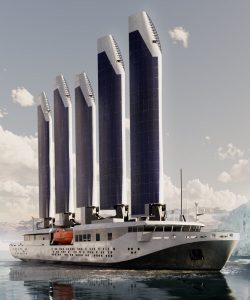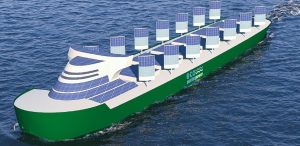Hybrid Marine Propulsion: Combining Diesel, Solar, and Wind
In a time when climate change stories fill our news feeds and sustainable advancements take center stage, the shipping sector stands at a pivotal moment. Conventional marine propulsion, which heavily depends on diesel engines, is facing heightened scrutiny due to its ecological impact. Thankfully, a solution that merges efficiency with eco-friendliness is gaining traction: hybrid marine propulsion.
So, what is hybrid marine propulsion, and why is it significant? Let’s explore the intriguing realm where diesel engines, solar panels, and wind sails collaborate seamlessly to drive vessels while minimizing their environmental impact.


What is Hybrid Marine Propulsion or Dual-mode Ship’s Engine?
At its essence, hybrid marine propulsion is a system that integrates two or more distinct energy sources to power a ship. Picture it like a hybrid vehicle but instead of mixing gasoline and electricity, we’re discussing diesel, solar power, and wind energy. These systems aim to enhance energy efficiency, reduce fuel consumption, and diminish greenhouse gas emissions.
There are various configurations available, but the fundamental concept remains consistent: utilize the most efficient energy source based on the operating conditions.
Why Hybrid? The Demand for Cleaner Oceans
To comprehend the motivation behind hybrid systems, it’s crucial to recognize the environmental toll of traditional shipping methods. Marine diesel engines, while powerful and dependable, are infamous for releasing sulphur oxides (SOx), nitrogen oxides (NOx), carbon dioxide (CO₂), and particulate matter. These pollutants contribute to global warming, ocean acidification, and health problems in coastal areas.
With the International Maritime Organization (IMO) tightening emission standards, shipowners are racing to discover cleaner options. Enter hybrid propulsion.
Examining the Trio: Diesel, Solar, and Wind Each energy source in a hybrid configuration offers distinct benefits. Let’s break it down:
-
Diesel Engines: The Responsible and Best Fit
Despite their environmental concerns, diesel engines remain crucial. They provide steady power, particularly during lengthy journeys or adverse weather when renewable sources may not suffice.
In a hybrid framework, diesel engines can be fine-tuned to operate at their most efficient levels, significantly lowering emissions. Furthermore, they often act as backup systems, activating only when solar or wind energy cannot fulfill the demand.
-
Solar Energy: Clean and Silent
Solar panels mounted on decks or rooftops transform sunlight into electricity. This renewable energy can recharge onboard batteries, power auxiliary systems, or even support propulsion through electric motors.
Solar power truly excels literally during daylight hours and in equatorial or tropical regions where sunlight is plentiful. It’s quiet, has zero emissions, and requires little maintenance.
However, there’s a limitation: solar energy is variable and reliant on weather conditions. That’s why it’s seldom the sole energy source for large vessels.
-
Wind Energy: The Revival of Sails
Believe it or not, wind-assisted navigation is experiencing a remarkable resurgence. Contemporary vessels are now equipped with rotor sails, kite sails, or rigid wingsails that capture wind energy far more efficiently than conventional fabric sails ever managed.
Wind propulsion does not produce electricity directly. Instead, it alleviates the strain on engines by delivering forward thrust, which in turn reduces fuel usage and emissions. When paired with diesel and solar power, it forms a formidable trio that can greatly enhance a ship’s range and operational efficiency.
How Do These Technologies Collaborate?
Picture a cargo ship navigating the Indian Ocean. Throughout the day, solar panels absorb sunlight, powering electrical systems and lightening the engine’s burden. Simultaneously, the ship’s sails harness the existing winds, contributing extra thrust. At night, or during periods of cloudy or calm weather, the diesel engine seamlessly takes control, ensuring constant propulsion.
This cooperative dynamic between energy sources enables vessels to adjust in real-time, shifting between power types according to environmental conditions and energy needs. Battery banks are essential, storing surplus energy from solar panels or regenerative systems for future use.
Real-World Examples of Hybrid marine propulsion and Success Stories
Hybrid marine propulsion is no longer a concept of the future—it’s already making waves. Here are some notable instances:
- MS Roald Amundsen: Run by Hurtigruten, this expedition cruise ship utilizes a diesel-electric hybrid system alongside substantial battery packs to lower emissions in delicate polar regions.
- Energy Observer: This groundbreaking research vessel merges solar, wind, and hydrogen fuel cells. It has traveled over 40,000 nautical miles without consuming any fossil fuels.
- Scandlines Ferries: Operating in the Baltic Sea, these hybrid ferries have reduced CO₂ emissions by up to 15,000 tons annually through battery-diesel combinations.
Clearly, the technology works—and it’s scaling fast.
Advantages of Hybrid Marine Propulsion
Still questioning whether hybrid systems are a worthwhile investment? Here are some compelling advantages:
Reduced Emissions
By decreasing dependency on diesel engines, hybrid systems significantly lower CO₂, NOx, and SOx emissions.
Enhanced Fuel
Efficiency Intelligent energy management leads to improved fuel economy—particularly on routes with varying conditions.
Increased Operational Flexibility
With multiple energy sources, vessels can adapt to diverse maritime environments, enhancing reliability and safety.
Future-Ready
As emission regulations tighten, early adoption of hybrid technology positions shipowners for compliance and long-term prosperity.
Challenges to Consider
Of course, no system is without its flaws. Hybrid marine propulsion does present a few obstacles:
- Higher Initial Costs: Installing various power systems and battery storage can incur significant expenses.
- Space Constraints: Solar panels and sails require deck space, which may limit cargo capacity.
- Technical Complexity: Managing and maintaining integrated systems necessitates skilled personnel and advanced software.
Nevertheless, the long-term savings in fuel and emissions often outweigh the initial investment—especially with rising carbon taxes and green incentives.
The Future Ahead: What Lies in Store for Hybrid Marine Propulsion ?
The maritime industry is rapidly transforming. With advancements in battery technology and enhancements in renewable energy systems, hybrid propulsion is set to become a standard rather than an anomaly.
Looking forward, breakthroughs such as fuel cells, ammonia-powered engines, and AI-enabled energy management solutions could further transform hybrid propulsion. Additionally, partnerships among shipbuilders, energy suppliers, and technology firms will be essential for realizing the complete potential of these systems.
Concluding Thoughts
The ocean may be immense, but its ability to absorb pollution is limited. As we reconsider our methods of transporting goods and people across the waters, hybrid marine propulsion emerges as an intelligent, scalable, and eco-friendly solution.
By merging the dependable nature of diesel with the clean potential of solar and wind energy, we are not merely powering vessels rather we are steering towards a more sustainable future.
So, the next time you see a ship adorned with shining solar panels and lofty sails on the horizon, you’ll understand: it’s not just navigating rather it’s pioneering a new path.


